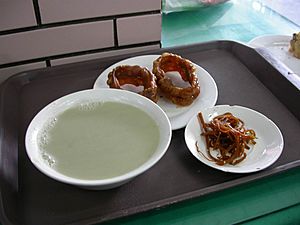Douzhi facts for kids
Douzhi (pronounced "doh-juh") is a special fermented drink from Beijing, China. It's a bit like soy milk, but instead of soybeans, it's made from mung beans. Douzhi is actually a leftover product from making cellophane noodles.
This unique drink has a slightly sour taste and a very strong, unusual smell, sometimes compared to rotten eggs. For many people, it's an acquired taste, meaning you might need to try it a few times to get used to it! In Beijing, people often enjoy Douzhi with crispy fried dough rings called jiaoquan and pickled vegetables.
Contents
What is Douzhi?
Douzhi is a traditional drink that has been enjoyed in Beijing for hundreds of years. It's made from mung beans, which are small, green beans often used in Asian cooking. The process of making Douzhi involves fermentation. This is a natural process where tiny living things like bacteria or yeast change the beans, giving the drink its unique flavor and smell.
How is it Made?
Making Douzhi starts by soaking mung beans in water. After they soften, the beans are ground into a paste. Water is then added to this paste, and it's filtered to separate the liquid from the solid parts. The liquid is used to make cellophane noodles. The leftover liquid, which is rich in nutrients from the beans, is then fermented. This fermentation process is what gives Douzhi its distinct sour taste and strong aroma.
Its Unique Taste and Smell
Douzhi is famous for its very strong smell, which some people find challenging. It's often described as having a sour, slightly vinegary, or even "rotten egg" scent. The taste is also quite sour, but many locals in Beijing love it as a warm, comforting drink, especially for breakfast. It's a true example of a local delicacy that shows the rich food culture of Beijing.
History of Douzhi
Douzhi has a long history in Beijing. It became popular during the Liao Dynasty (907–1125 AD) and was even enjoyed by emperors during the Qing Dynasty (1644–1912 AD). For centuries, it has been a common and affordable drink for ordinary people in Beijing. It was a way to use all parts of the mung bean when making noodles, showing how people were resourceful with their food.
Douzhi Today
Today, Douzhi is still a beloved part of Beijing's food scene. You can find it in traditional restaurants, small street stalls, and even some modern cafes. While its strong smell might surprise visitors, trying Douzhi is a unique cultural experience. It's a taste of old Beijing and a reminder of the city's rich culinary traditions.
See also
 In Spanish: Douzhi para niños
In Spanish: Douzhi para niños


